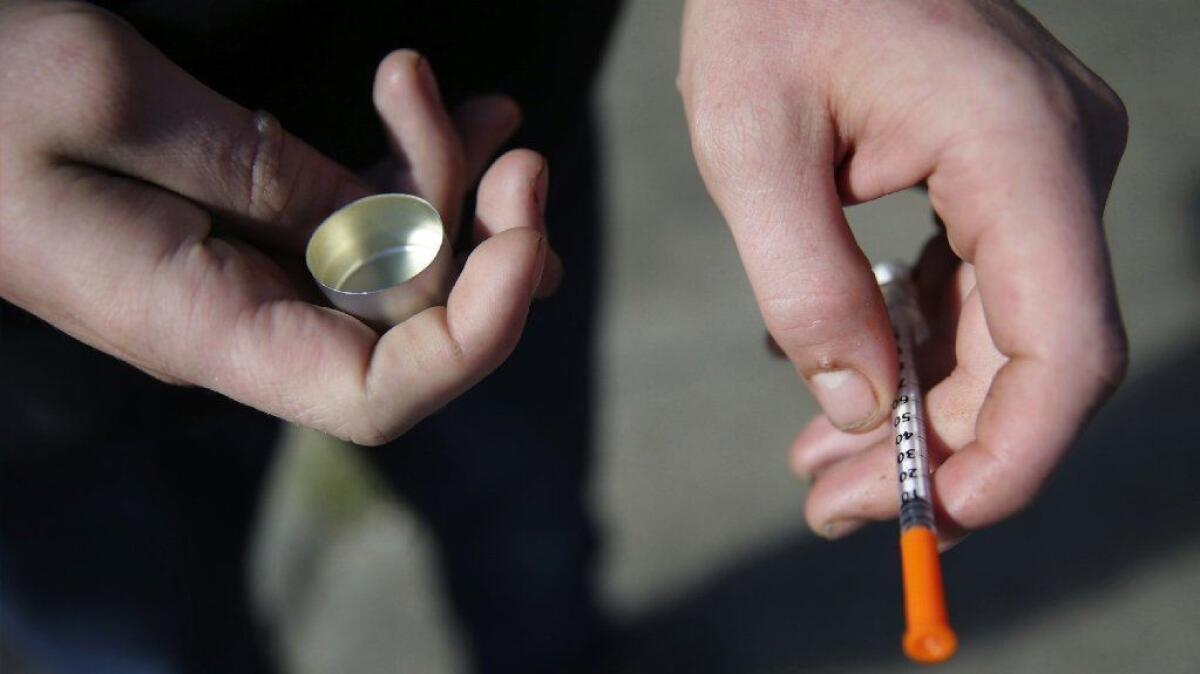Editorial: Mr. President, the real national emergency is fentanyl

President Trump and his minions cooked up a fake national security crisis to justify diverting billions of dollars to build a bigger, wider border wall to keep out of the hordes of immigrants he imagines marching across the deserts, hills and prairies between established ports of entry. It’s bad enough that he’s wasting money and time on a manufactured crisis, but it’s all the worse that he’s doing so when the U.S. is facing an actual crisis — one that is killing tens of thousands of Americans every year — and doing little to stop it.
In 2017, the most recent year for which we have good data, more than 70,000 Americans died from drug overdoses. Nearly 50,000 of those deaths involved opioids. New government data released this month show that a key driver of the overdose deaths in the last few years has been the spread of fentanyl, a synthetic opioid that has been mixed in with heroin and other illicit drugs. Extraordinarily potent, fentanyl is killing unwitting users in rapidly growing numbers.
If tens of thousands of accidental deaths every year is not a true national emergency, then what is?
The administration declared opioid overdose a public health emergency in 2017 but hasn’t treated it as such, focusing on small steps and, at the same time, weakening the programs that might actually save lives. The day before the fentanyl report was released, Trump’s senior adviser Kellyanne Conway outlined the administration’s efforts to get ahead of the opioid crisis, and they were underwhelming. She touted drug take-back programs, restrictions on prescription opioids and expanded Medicaid support for babies born addicted to opioids. These aren’t necessarily bad, but they miss the mark. Prescription opioids are implicated in a shrinking number of overdose deaths. And even as the administration is pursuing care for more addicted babies, the president is seeking to cut spending on Medicaid, which the most important source of funds to treat addicted adults.
Enter the Fray: First takes on the news of the minute »
Meanwhile, the president’s “opioid cabinet” seem to be fixated on two things that are unlikely to stop the dying any time soon: enhancing penalties for drug dealers (and perhaps executing them, an idea that Trump has espoused), though we already have adequate penalties, and building that border wall. Evidently the administration sees the wall as not just a bulwark against illegal immigrants and dangerous terrorists, but also as a barrier to the Chinese-manufactured fentanyl that’s smuggled into the U.S. from Mexico. While testifying before a congressional committee earlier this month, James Carroll, the director of the Office of National Drug Control Policy, echoed the administration line that a border wall will curb the inflow of illegal fentanyl despite the fact that about 90% of the seized illegal drug shipments coming from Mexico are grabbed at legal ports of entry.
Here are some of the strategies that should be part of the administration’s action plan: Spend a lot more (maybe some of that border wall money?) on addiction treatment programs, and remove barriers to prescribing buprenorphine, an effective medical-assisted treatment for addiction. Focus more resources on helping shut down fentanyl manufacturing abroad. Make drug-checking test strips widely available to drug users so they can determine if fentanyl is present in their stash of illegal drugs. (Fentanyl has been showing up in batches of cocaine and methamphetamine, where users might not expect to find opioids). Make naloxone widely available to users because fentanyl is so potent and fast-acting that people can overdose in seconds; other countries report success with take-home naloxone programs. And stop trying to shut down efforts by some U.S. cities interested in pilot programs for supervised injection sites that may keep addicts alive.
Some experts think that fatal overdoses will continue to rise over the next few years. Trump administration officials need to get their collective heads out of the sand before the problem gets farther out of hand.
Follow the Opinion section on Twitter @latimesopinion and Facebook
More to Read
A cure for the common opinion
Get thought-provoking perspectives with our weekly newsletter.
You may occasionally receive promotional content from the Los Angeles Times.






